Ys has always been one of my favorite game series. The series began in 1987 on the NEC PC-8801, and was later ported to literally over a dozen different consoles and computer systems, ranging from the NES and Apple IIGS to even the PlayStation Portable and Nintendo DS. Most of these contained subtle differences in graphics and music until 1998′s Ys Eternal for PC, which was a full-blown sound and graphic overhaul. Interestingly enough, aside from minor expansions to the world, the original dungeon layouts would remain mostly the same between every version. I find this both charming, and disappointing at the same time. Knowing where everything is and how to solve all the puzzles can be fun, but some variation in the dungeon design would be appreciated. The Nintendo DS version throws in an extra dungeon and boss to add something new to the mix but there haven’t been many changes since 1987. Depending how you consider the alternate releases of Ys IV and if you consider Ys Origin to be part of the main series or not, the Ys series has spawned seven main titles, a number of spinoffs, an anime series, audio dramas, and manga.
In Japan, Ys has held strong as a very popular franchise, named along side Final Fantasy as peoples favorites, but in the western world, it remained relatively unknown until 2006 when Konami would release Ys VI: The Ark of Naphistim on PSP and PS2. Prior to that, the most widespread Ys release was the black sheep of the series, 1991′s Ys III: Wanderers from Ys, which took a vastly different approach than the other iterations. This would appear on the more mainstream Sega Genesis/Mega Drive and the Super NES along with the TurboGrafx-16 version. Unfortunately, Ys IV and Ys V to this day haven’t seen the light of day outside Japan officially. The original Ys was very obscure in the US, appearing only on DOS, Apple IIGS, Sega Master System, and ultimately TurboGrafx-16 until about 2009. I’d like to focus my attention today on the TurboGrafx-16 version, Ys Book I & II.
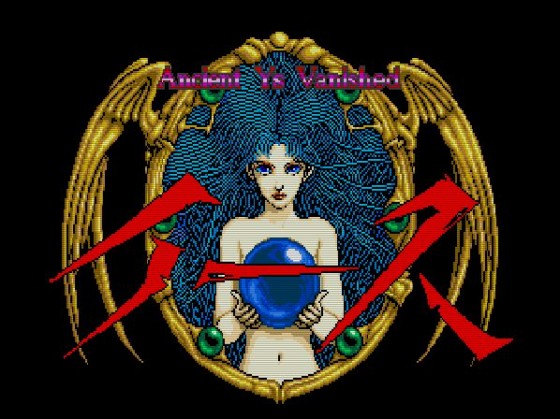
Title screen. Interesting how they left the Japanese characters?
As one of the first console games to use CD-ROM technology, and also one of the first games to use CD-Audio music and FMV cut scenes, Ys Book I & II was truly a pioneer of it’s time. Most people saw it as a pack-in game for the TurboDuo system. The TurboDuo was an all-in-one version of the TurboGrafx-16 and the CD-ROM add-on system, similar to what the Sega CDX or JVC X’eye were to the Sega Genesis and Sega CD. Part of what made Ys Book I & II so special was that it was the first time Ys II had appeared in the West and would be the only time it would appear in the West officially until XSEED would release the hand held versions on PSP and Nintendo DS. It’s a shame really, because as great the original Ys is, Ys II is where the series adopts most of it’s staples. The developer had also done something really interesting with the compilation, and instead of having you select Ys I or Ys II to play separately, you simply play through both back to back as though they were one single game. You do feel the transition through a short intermission movie and the loss of equipment and gold, but you keep your levels and experience points. All in all, this does make the game easier, since you can level up far beyond what you need to have to beat Ys 1, and although they ramped up the difficulty at the start of Ys 2 to accommodate, the number of levels you gained gives you a running start towards the second half of your adventure, taking away the need to grind out some experience before undertaking the quest at hand. It makes a lot of sense that the games would be strung together this way, after all, the original full titles of both games are Ys: Ancient Ys Vanished and Ys 2: Ancient Ys Vanished -The Final Chapter-.
The story of Ys isn’t too terribly complicated. It’s actually loosely –very loosely– based on a folk legend. In the myth, Ys was a glorious city that was eventually lost to the sea, where as in the game Ys is more of a province that was levitated into the sky. There have been a number of other stories, books, lore and even paintings that have been inspired by the legend of Ys, but the game series has very little to do with that. It’s interesting if you’re into that kind of history, though. In the Ys games, you play as Adol Christin, or Aron depending on which version of the game you play. Most of the translations across the different platforms aren’t very consistent. Your adventures have brought you to the land of Esteria, where Adol is greeted by a fortune teller who warns him of a great evil roaming the land. Adol must seek out the six Books of Ys, to unveil the secrets of the land of Ys to aid in defeating Dark Fact, who’s been stealing silver goods and terrorizing in the land. A couple of mysterious girls with an incredible secret aid him along the way. Ys II ups the ante, with a much richer storyline, literally picking up right at the end of the first game. Adol awakes with a girl named Lilia by his side, in Lance village. He must explore the ancient land of Ys to further investigate why it disappeared so long ago.
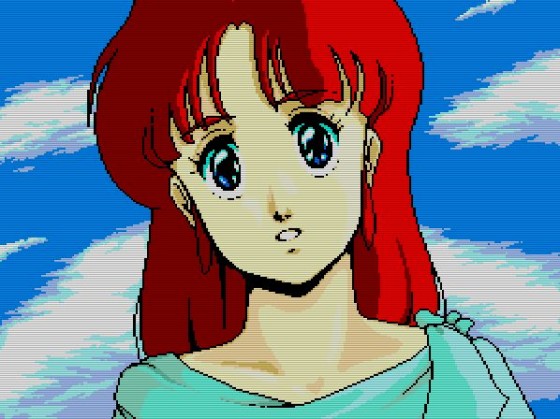
Lilia, our doe-eyed female companion.
The game play to the Ys series in general is fairly simplistic. Most of the earlier games use what’s become known as the “bump” system. Originally developed on PC, the creators wanted to make something simplistic enough to be accessible by a large audience. Instead of using your sword in the style of Zelda or Neutopia, you simply run into the enemies, closer to Hydlide and some of the Xak games. Depending on which side of certain enemies you hit and your stats will determine the damage you deal to them and in some cases the damage you’d recieve. A lot of people turn their nose up at it, including myself at first, but now I couldn’t imagine playing the older Ys games a different way. During Ys I there isn’t a lot of variation with combat, but Ys II throws some magic spells into the mix, and you’ll be casting fireballs, and changing into creatures to take away a bit of the monotonous feel of the first part of the game.
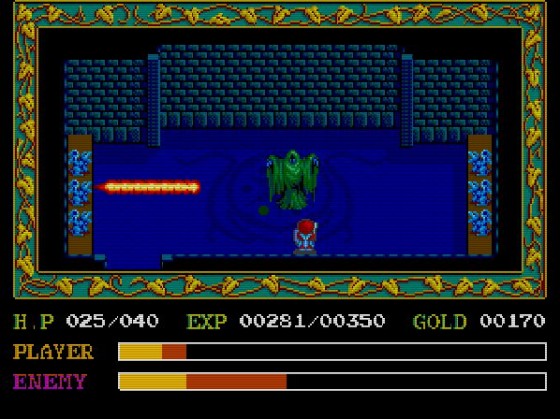
Crashing into a boss. Avoid the flames!
Although Ys I did stand on it’s own as far as length, most people would find it rather short. It may take about six hours your first time through, less if you know some secrets to give you a bit of a starting boost. There’s about five main areas to explore, with the vast majority of the game spent in Dharm Tower, where you’re introduced to another character who became a series staple, Dogi, otherwise known as Colin. Again, the translations weren’t always consistent. Most of the games length feels artificially prolonged by forcing you to backtrack and by making bosses frustrating more so than challenging. This is less of an issue in the TurboGrafx version than the others, due to the expanded number of levels allotted to you. I found the Saturn version, and the original PC version of Ys Eternal to be nearly impossible. Even at the maximum level and with the best equipment available most of the bosses towards the middle through the end of the game would simply deal too much damage or take too little. I’m told Ys Eternal was changed with patches and upgrades which added some different difficulty settings. Regardless, a good number of the bosses will bring you back to the controller-throwing days of yore. Ys II is much more solid, which balances out the total experience. Being twice as long, it also delivers more than twice the number of areas as the first game, and they’re a lot more diverse. Instead of a dark temple, a dark mine, and a 25 story tower, you’ll wander from snow field, to volcano, to ancient temple, to…another dark mine. The bosses are a lot more diverse and creative, rather than just having a large HP bar and attacks that kill you in a few hits.
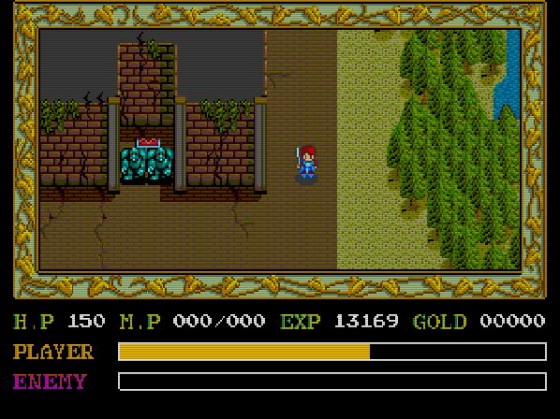
The Ruins of Moondoria!
The music is what makes this version of Ys stand out among the others. The Ys series in general is known for having incredible soundtracks, ranging from orchestral pieces to boss themes with heavy metal influences. Even if you hate RPGs and never want to play Ys, I’d still suggest giving the soundtracks a listen. They’re some of the best that have ever been produced. In 1991, when the TurboGrafx version had come out, games being on CDs were a new thing. The Sega CD was still a ways away, and a lot of critics still wondered why CDs were the media to move to, as they were still very expensive at the time. Ys Book 1 and 2 gave them a reason. Most of the music is composed by the famous Yuzo Koshiro, the composer behind Streets of Rage, ActRaiser, and the more recent Etrian Odyssey series . From the title screen you’re greeted with an extremely high quality orchestral piece, with full voice over. From there you’re sent to the opening movie with a rock-ish, pop-ish piece that screams 1980′s. It’s a beautiful thing. Each piece of music sets the tone of the game properly, and gets you pumped for the action. From the opening title, to the fight with Dark Fact, to the final fight with Dharm, every single track is simply breathtaking. While all of the other versions of Ys have fantastic music as well, the this version still stands about above them, as most of them don’t quite have the same rock influence. It’s a product of its time, and I wouldn’t have it any other way.
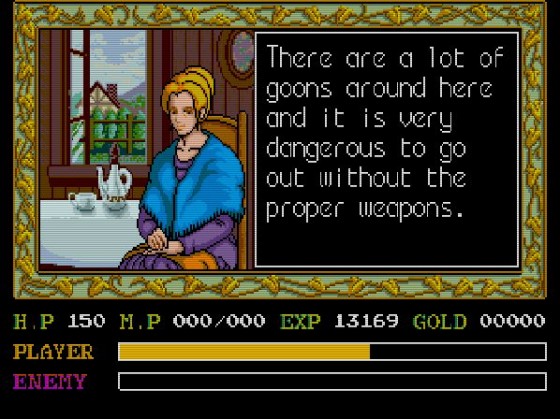
Goons?! I guess it’s dangerous to go alone.
Being one of the first console games on CD-ROM, as I mentioned before, it is one of the first console games to feature voice acting. We’ve come a long way since 1990, but what they did then is still impressive, even though it’s a bit campy. The cast included Alan Oppenheimer, Jim Cummings, and Michael Bell, among others of Saturday morning cartoon fame. They certainly did better than some other games that appeared on the system, where it felt like they literally pulled someone from the office to record a couple lines before sending them back to sort the mail.
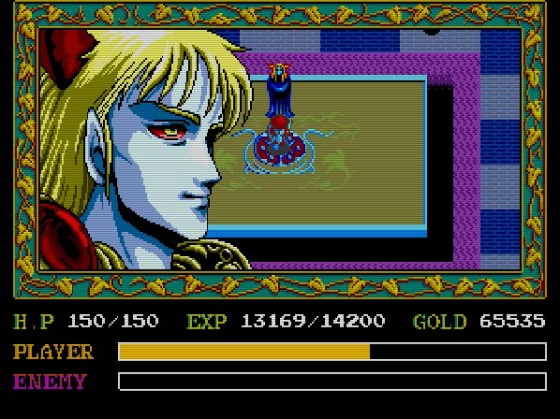
Duke? Is that you? Oh, it’s Dark Fact, my mistake.
The graphics are standard fare for the early 16-bit era, and a lot of people will be put off by the amount of blank space on the screen. The entire game is displayed inside a frame, with your status bar being displayed below. Again, it’s the game showing its roots as an early PC game. Aside from the movies, it doesn’t exactly show off the power of the TurboGrafx, as it only used the basic CD-Rom System Card capabilities. Again, despite being packaged as a single game, there is a slight difference in the graphics in Ys II. Most of this is due to the more varied environments and enemies. The later Ys IV: The Dawn of Ys would be an incredible improvement, but that’s a discussion for another time. Although the later versions of Ys I and II would have immense graphical improvements, for nearly a decade this would remain the definitive version of the game.
The first time I played Ys Books I & II was nearly two decades ago, and even today it remains in my heart as one of my favorite games of all time. I wish it got more recognition in the West, and in recent years it’s starting to, but it doesn’t quite have the same fandom as it has in Japan. All of the recent Ys games are fairly accessible. You can get Ys Origin, which is a side story taking place before the first Ys game, off of Steam along with Ys: The Oath in Felghana, which is a full blown remake of Ys III. Ys Seven (Yep, not Ys VII…only Falcom knows why) recently released on the PSP which takes the series in a bit different direction, adding in the ability to play as Dogi and other companions. Oath in Felghana and Ys I & II Chronicles are still relatively easy to find on the PSP as well, with Ys VI being a bit more obscure. There’s a number of different versions of Ys I and II floating around, obtainable in a number of different ways, from UMD to Virtual Console. Whichever version you choose to try, there really isn’t a “bad” one unless you’re firing up your 286. I strongly recommend checking out the TurboGrafx-16 version, be it either though finding the actual game disc, or digitally on your Wii. If you have tried it, and didn’t care for it, I’d suggest at least trying to power through to see Ys II before making your final judgment. And always remember, it’s Ys, not Y’s. Happy gaming! See you next time!


